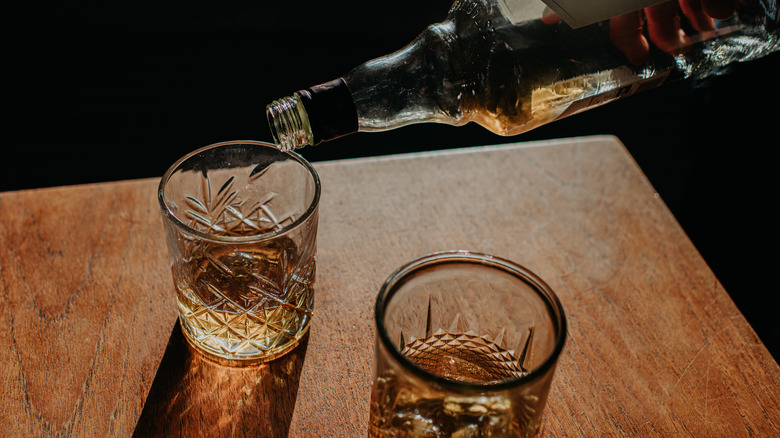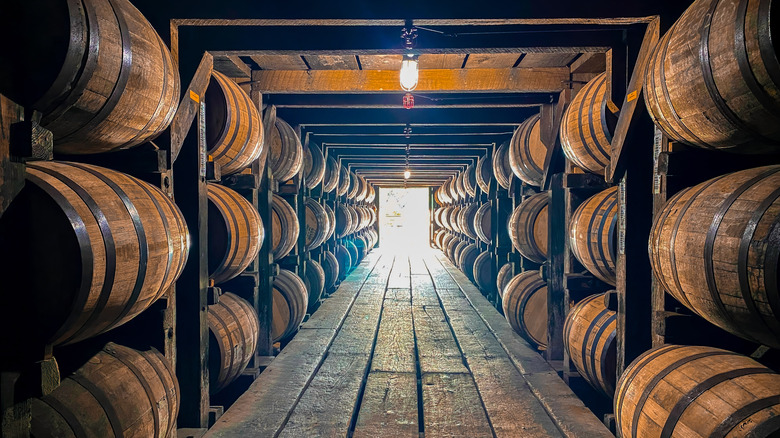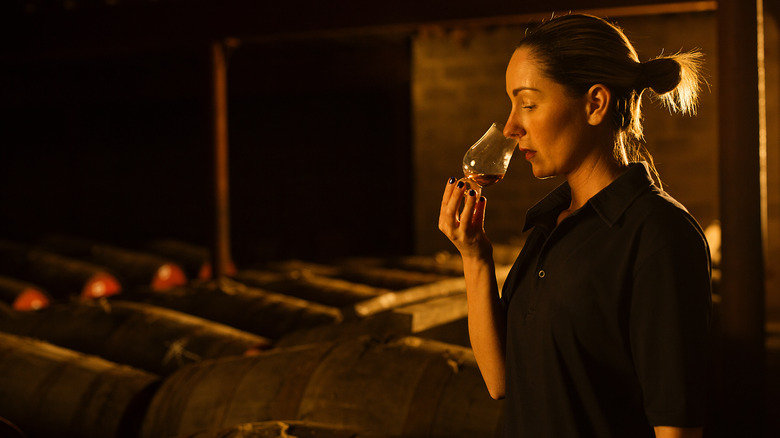What Is Hazmat Whiskey, And Why Would You Even Want It?
The American whiskey world is currently abuzz because the federal government finally approved American single malt (made from 100% malted barley) as a legally defined style of whiskey, like bourbon. But there are other, less formal kinds of this alcohol that will probably never become legal canon, including high-proof "hazmat" whiskey. Hazmat?
If you haven't heard of hazmat-style whiskey, don't feel bad. There aren't a lot of brands highlighting it ... yet. But it's definitely becoming more prevalent. Essentially, "hazmat" is an insider term to describe whiskeys bottled at or above 140 proof (70% alcohol by volume). To put that in perspective, most distilled spirits are bottled at 80 to 100 proof. The idea behind the name is that spirits below 70% ABV can be legally packed in your checked airplane luggage, but anything above that is considered a hazardous material (hence "hazmat"). These very high-proof whiskeys informally earned the moniker over a decade ago, but in the past couple of years, it seems more brands are embracing the term and encouraging whiskey fans to go big and go bold.
Most whiskey comes off the still somewhere around the 100- to 140-proof level, but these numbers can vary quite a bit. By law, most official categories like bourbon, rye, and the new American single malt cannot be distilled above 160 proof, and most must enter the barrel for aging below 125 proof (adding water brings down the proof). So where do these extra strong beasts come from?
The evolution of hazmat whiskey
There are a few ways to achieve very high-proof whiskey. So-called "light whiskey" must come off the still between 160 and 190 proof, and American concoctions without a specific classification have fewer restrictions. The other method relies on chemistry: Liquor that's barrel-aged in warm weather climates (like Kentucky) become stronger as they age because more water in the spirit evaporates during each heat cycle. Using small barrels accelerates this process (more of the whiskey is in direct contact with wood), also creating a stronger drink.
In the past decade, high-proof cask-strength whiskeys have become popular with fans and collectors. Aficionados say it gives a truer sense of the distiller or blender's vision. As people clamor for high-proof expressions, reaching for the stars seems (possibly) natural. "Stagg had a release that was about 72% and people started to call it 'hazmat,'" veteran whiskey writer and advocate Chuck Cowdery told Chowhound. "That was maybe 15 years ago."
Jonah Flicker, writing for VinePair, observed (while sampling a 168-proof, 23-year-old Canadian whiskey) that hazmat-style whiskies have been popping up more frequently. In 2021, Kings County Distillery in Brooklyn released its Blender's Reserve at 140 proof. This year, in 2024, Lost Lantern and Corbin Cash, a California distillery, partnered to unveil 200 bottles of California Straight Bourbon Single Cask at 146.2 proof. And Jack Daniels' 2021 Single Barrel Special Release–Coy Hill High Proof clocked in at 141.8 proof, the highest ever released by the Tennessee distillery.
How to drink a hazmat whiskey: carefully
Most recently, the World Whiskey Society (WWS) debuted the Wyatt Earp "Hazmat" 13-Year. The drink (crafted mostly from malted barley) is bottled at a whopping 160 proof (80% ABV), and every percentage of alcohol is on display when you take a sip: It's big, brash, bold, and makes you catch your breath. The expression might be the first to actually feature the term "hazmat" on the bottle.
So how and why would you drink something so strong? You might be surprised to discover that underneath all that heat, there are discernible layers of complex flavor. Sipping it neat allows you to taste what CEO Alex Kogan tasted when the WWS acquired the barrels. "The whiskey inside was around 160 proof," he told Chowhound. "This is attributed mostly to the climate where it was stored, in California."
This sense of authenticity or presence reflects the sentiments of other blenders and distillers putting out hazmat whiskey. "It was never thought of as a high-proof whiskey," Jack Daniel's distiller Chris Fletcher told us of the Coy Hill releases. Notably, he said it's as close as the brand can get to taking people on a tour through specific barrel houses.
The other approach is to cut the whiskey with a little water, a not an uncommon tactic for whiskey fans. A bit of water (or more) opens up aromas and flavors masked at a higher proof. Which begs the question: Why wasn't it watered down in the first place? It would cause degradation of compounds important for the taste of the alcohol.


